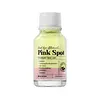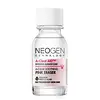What's inside
What's inside
 Key Ingredients
Key Ingredients

 Benefits
Benefits

 Concerns
Concerns

 Ingredients Side-by-side
Ingredients Side-by-side

Water
Skin ConditioningAlcohol
AntimicrobialGlycerin
HumectantCalamine
AbsorbentCoptis Japonica Root Extract
Skin ConditioningZinc Oxide
Cosmetic ColorantDimethyl Sulfone
SolventGlycolic Acid
BufferingCamphor
MaskingSalicylic Acid
MaskingPEG-60 Hydrogenated Castor Oil
EmulsifyingButylene Glycol
HumectantPropanediol
Solvent1,2-Hexanediol
Skin ConditioningCentella Asiatica Extract
CleansingHouttuynia Cordata Extract
Skin ConditioningSalvia Hispanica Seed Extract
EmollientPortulaca Oleracea Extract
Skin ConditioningCitrus Limon Fruit Extract
MaskingMelaleuca Alternifolia Leaf Extract
PerfumingMelaleuca Alternifolia Leaf Oil
AntioxidantVaccinium Macrocarpon Fruit Extract
AstringentRubus Idaeus Fruit Extract
AstringentPrunus Serotina Fruit Extract
MaskingCornus Officinalis Fruit Extract
Skin ConditioningPunica Granatum Fruit Extract
AntioxidantCitrus Aurantium Dulcis Peel Oil
MaskingSilica
AbrasiveCaprylyl Glycol
EmollientIllicium Verum Fruit Extract
PerfumingEthylhexylglycerin
Skin ConditioningWater, Alcohol, Glycerin, Calamine, Coptis Japonica Root Extract, Zinc Oxide, Dimethyl Sulfone, Glycolic Acid, Camphor, Salicylic Acid, PEG-60 Hydrogenated Castor Oil, Butylene Glycol, Propanediol, 1,2-Hexanediol, Centella Asiatica Extract, Houttuynia Cordata Extract, Salvia Hispanica Seed Extract, Portulaca Oleracea Extract, Citrus Limon Fruit Extract, Melaleuca Alternifolia Leaf Extract, Melaleuca Alternifolia Leaf Oil, Vaccinium Macrocarpon Fruit Extract, Rubus Idaeus Fruit Extract, Prunus Serotina Fruit Extract, Cornus Officinalis Fruit Extract, Punica Granatum Fruit Extract, Citrus Aurantium Dulcis Peel Oil, Silica, Caprylyl Glycol, Illicium Verum Fruit Extract, Ethylhexylglycerin
Water
Skin ConditioningAlcohol Denat.
AntimicrobialCalamine
AbsorbentGlycerin
HumectantMelaleuca Alternifolia Leaf Oil
AntioxidantAsiaticoside
AntioxidantMadecassic Acid
Skin ConditioningAsiatic Acid
Skin ConditioningMadecassoside
AntioxidantCamellia Sinensis Leaf Extract
AntimicrobialOpuntia Coccinellifera Fruit Extract
Skin ConditioningCentella Asiatica Extract
CleansingSapindus Trifoliatus Fruit Extract
Skin ConditioningCamellia Japonica Seed Extract
Skin ConditioningCamellia Japonica Flower Extract
EmollientCitrus Unshiu Peel Extract
MaskingRubus Idaeus Fruit Extract
AstringentCymbopogon Citratus Extract
Skin ConditioningMelissa Officinalis Leaf Extract
Skin ConditioningVaccinium Angustifolium Fruit Extract
Skin ProtectingCitrus Aurantium Dulcis Fruit Extract
MaskingCarica Papaya Fruit Extract
Skin ConditioningCamellia Japonica Leaf Extract
Skin ConditioningGuaiazulene
AntimicrobialPanthenol
Skin ConditioningGlycyrrhiza Glabra Root Extract
BleachingRubus Fruticosus Fruit Extract
AstringentSalicylic Acid
MaskingPEG-60 Hydrogenated Castor Oil
EmulsifyingTrideceth-10
CleansingButylene Glycol
Humectant1,2-Hexanediol
Skin ConditioningEthylhexylglycerin
Skin ConditioningWater, Alcohol Denat., Calamine, Glycerin, Melaleuca Alternifolia Leaf Oil, Asiaticoside, Madecassic Acid, Asiatic Acid, Madecassoside, Camellia Sinensis Leaf Extract, Opuntia Coccinellifera Fruit Extract, Centella Asiatica Extract, Sapindus Trifoliatus Fruit Extract, Camellia Japonica Seed Extract, Camellia Japonica Flower Extract, Citrus Unshiu Peel Extract, Rubus Idaeus Fruit Extract, Cymbopogon Citratus Extract, Melissa Officinalis Leaf Extract, Vaccinium Angustifolium Fruit Extract, Citrus Aurantium Dulcis Fruit Extract, Carica Papaya Fruit Extract, Camellia Japonica Leaf Extract, Guaiazulene, Panthenol, Glycyrrhiza Glabra Root Extract, Rubus Fruticosus Fruit Extract, Salicylic Acid, PEG-60 Hydrogenated Castor Oil, Trideceth-10, Butylene Glycol, 1,2-Hexanediol, Ethylhexylglycerin
Ingredients Explained
These ingredients are found in both products.
Ingredients higher up in an ingredient list are typically present in a larger amount.
1,2-Hexanediol is a synthetic liquid and another multi-functional powerhouse.
It is a:
- Humectant, drawing moisture into the skin
- Emollient, helping to soften skin
- Solvent, dispersing and stabilizing formulas
- Preservative booster, enhancing the antimicrobial activity of other preservatives
Butylene Glycol (or BG) is used within cosmetic products for a few different reasons:
Overall, Butylene Glycol is a safe and well-rounded ingredient that works well with other ingredients.
Though this ingredient works well with most skin types, some people with sensitive skin may experience a reaction such as allergic rashes, closed comedones, or itchiness.
Learn more about Butylene GlycolWe don't have a description for Calamine yet.
Centella Asiatica Extract (Centella) is derived from an herb native to Southeast Asia. It is famous for its anti-inflammatory and soothing properties.
Centella is rich in antioxidants and amino acids, such as Madecassic Acid and Asiaticoside.
Studies show the compounds in centella help with:
The combination of all these properties makes centella effective at soothing, hydrating, and protecting the skin.
Other great components of centella include Vitamin A, vitamin C, several B vitamins, and Asiatic Acid.
Fun fact: Centella has been used as a medicine and in food for many centuries. As a medicine, it is used to treat burns, scratches, and wounds.
Learn more about Centella Asiatica ExtractEthylhexylglycerin (we can't pronounce this either) is commonly used as a preservative and skin softener. It is derived from glyceryl.
You might see Ethylhexylglycerin often paired with other preservatives such as phenoxyethanol. Ethylhexylglycerin has been found to increase the effectiveness of these other preservatives.
Glycerin is already naturally found in your skin. It helps moisturize and protect your skin.
A study from 2016 found glycerin to be more effective as a humectant than AHAs and hyaluronic acid.
As a humectant, it helps the skin stay hydrated by pulling moisture to your skin. The low molecular weight of glycerin allows it to pull moisture into the deeper layers of your skin.
Hydrated skin improves your skin barrier; Your skin barrier helps protect against irritants and bacteria.
Glycerin has also been found to have antimicrobial and antiviral properties. Due to these properties, glycerin is often used in wound and burn treatments.
In cosmetics, glycerin is usually derived from plants such as soybean or palm. However, it can also be sourced from animals, such as tallow or animal fat.
This ingredient is organic, colorless, odorless, and non-toxic.
Glycerin is the name for this ingredient in American English. British English uses Glycerol/Glycerine.
Learn more about GlycerinThis tea tree oil comes from the leaves of the Tea Tree plant. Tea tree oil has antioxidant, anti-inflammatory, and antimicrobial properties.
According to the book Journal of Profiles of Drug Substances, tea tree helps in reducing acne-causing bacteria such as Propionibacterium acnes. This is due to the Terpinen components of tea tree oil.
Tea tree may cause sensitivity and irritation for some people. This oil naturally contains fragrance such as linalool and limonene.
However, research shows irritation usually occurs when using pure tea tree oil and not in cosmetic products.
Tea tree oil was found to help relieve the symptoms of psoriasis in one study.
Tea tree oil is toxic when ingested. Another study showed it to caused damage to the nervous system of dogs and cats when applied to their skin or given orally.
Learn more about Melaleuca Alternifolia Leaf OilPeg-60 Hydrogenated Castor Oil comes from hydrogenated castor oil. It is a solubilizer and emulsifier.
As a solubilizer, it helps dissolve ingredients into a water-based version. It is also an emulsifer. Emulsifier help prevent oils and water from separating. Both these properties help create evenly-spread and uniform products.
Basically, Peg-60 Hydrogenated Castor Oil helps hold ingredients together.
Learn more about PEG-60 Hydrogenated Castor OilWe don't have a description for Rubus Idaeus Fruit Extract yet.
Salicylic Acid (also known as beta hydroxy acid or BHA) is a well-known ingredient for treating skin that struggles with acne and clogged pores. It exfoliates both the skin's surface and deep within the pores to help clear out buildup, control oil, and reduce inflammation.
Unlike AHAs (alpha hydroxy acids), salicylic acid is oil-soluble. This allows it to penetrate into pores which makes it especially effective for treating blackheads and preventing future breakouts.
Salicylic acid is also known for its soothing properties. It has a similar structure to aspirin and can calm inflamed or irritated skin, making it a good option for acne-prone skin that is also sensitive.
Concentrations of 0.5-2% are recognized by the U.S. FDA as an over-the-counter topical acne product.
It can cause irritation and/or dryness if one's skin already has a compromised moisture barrier, so it's best to focus on repairing that before introducing this ingredient into your routine.
While salicylic acid does not increase sun sensitivity, it’s still important to wear sunscreen daily to protect your skin.
If you are looking for the ingredient called BHA or Butylated Hydroxyanisole, click here.
Learn more about Salicylic AcidWater. It's the most common cosmetic ingredient of all. You'll usually see it at the top of ingredient lists, meaning that it makes up the largest part of the product.
So why is it so popular? Water most often acts as a solvent - this means that it helps dissolve other ingredients into the formulation.
You'll also recognize water as that liquid we all need to stay alive. If you see this, drink a glass of water. Stay hydrated!
Learn more about Water